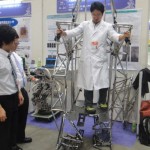Archive for Сентябрь 28th, 2011
Новая модель движения экзоскелета использует переменный цент тяжести.
- Тип контента: Новостная статья
- Номер документа: 4599
- Название документа: "Экзоскелет" работающий без электричества (видео)
- Номер (DOI, IBSN, Патент): Не заполнено
- Изобретатель/автор: Не заполнено
- Правопреемник/учебное заведение: Не заполнено
- Дата публикации документа: 2011-09-28
- Страна опубликовавшая документ: Россия
- Язык документа: Русский
- Наименование изделия: Не заполнено
- Источник: http://www.24gadget.ru/1161046818-ekzoskelet-rabotayuschiy-b
- Вложения: Не заполнено
- Аналитик: Helix
 Японские ученые создали двуногого робота, который отличается исключительной устойчивостью. В действие робота приводят движения человека. Машина может ходить, используя центр тяжести человека, который ею управляет.
Японские ученые создали двуногого робота, который отличается исключительной устойчивостью. В действие робота приводят движения человека. Машина может ходить, используя центр тяжести человека, который ею управляет.
Категория: Управление | Нет комментариев »
Initial analysis of EMG signals of hand functions associated to rehabilitation tasks
- Тип контента: Научная статья
- Номер документа: 1368
- Название документа: Initial analysis of EMG signals of hand functions associated to rehabilitation tasks
- Номер (DOI, IBSN, Патент): 10.1109/ROBIO.2009.4913058
- Изобретатель/автор: Low, K.H., Lim, H.B., Huang, Y.Y.
- Правопреемник/учебное заведение: Sch. of Mech. & Aerosp. Eng., Nanyang Technol. Univ., Singapore
- Дата публикации документа: 2009-05-08
- Страна опубликовавшая документ: Сингапур
- Язык документа: Английский
- Наименование изделия: Не заполнено
- Источник: http://ieeexplore.ieee.org/search/freesrchabstract.jsp?tp=&a
- Вложения: Не заполнено
- Аналитик: Не заполнено
 The objective of this work is to study the EMG signals based on hand motions for specified tasks, and different gripping conditions so as to identify patterns of EMG signals. This will allow therapists to identify weak muscles of patients with motor weakness, such as spinal cord injury (SCI) and post-stroke and concentrate on rehabilitation activities which can strengthen these specific muscles. At the same time, it is hoped that the analysis is able to provide useful data for objective and quantitative assessment towards control applications on the hand rehabilitation device, which is being developed. The analysis of the EMG signals for various hand muscles during functional motions and prehensile tasks has been carried out. The method to identify individual hand motions from EMG signals is described. The EMG signals associated to physical parameters are also illustrated in this paper. Finally, the preliminary works and future research are concluded.
The objective of this work is to study the EMG signals based on hand motions for specified tasks, and different gripping conditions so as to identify patterns of EMG signals. This will allow therapists to identify weak muscles of patients with motor weakness, such as spinal cord injury (SCI) and post-stroke and concentrate on rehabilitation activities which can strengthen these specific muscles. At the same time, it is hoped that the analysis is able to provide useful data for objective and quantitative assessment towards control applications on the hand rehabilitation device, which is being developed. The analysis of the EMG signals for various hand muscles during functional motions and prehensile tasks has been carried out. The method to identify individual hand motions from EMG signals is described. The EMG signals associated to physical parameters are also illustrated in this paper. Finally, the preliminary works and future research are concluded.
Категория: Ищем научные статьи | 1 Комментарий »
Development of anteversion posture support system
- Тип контента: Научная статья
- Номер документа: 1364
- Название документа: Development of anteversion posture support system
- Номер (DOI, IBSN, Патент): 10.1109/ROBIO.2009.4913083
- Изобретатель/автор: Nozaki, H., Kobayashi, H.
- Правопреемник/учебное заведение: Dept. of Mech. Eng., Tokyo Univ. of Sci., Tokyo
- Дата публикации документа: 2009-05-08
- Страна опубликовавшая документ: Япония
- Язык документа: Английский
- Наименование изделия: Не заполнено
- Источник: http://ieeexplore.ieee.org/search/freesrchabstract.jsp?tp=&a
- Вложения: Не заполнено
- Аналитик: Не заполнено
 We have been developing a wearable robot that directly and physically supports human movement. A ldquomuscle suitrdquo for the arm that will provide muscular support for the paralyzed or those otherwise unable to move unaided is one example. Whereas low back pain is one of the most serious issue for the manual worker and in this paper, we focus on developing the support system for anteversion posture support. In this paper, the concept and mechanical structure of the support system is shown. From the experimental result to keep anteversion posture with load indicates our system is very effective for keeping anteversion posture and it becomes clear that more than 60% reduction of muscular power is possible.
We have been developing a wearable robot that directly and physically supports human movement. A ldquomuscle suitrdquo for the arm that will provide muscular support for the paralyzed or those otherwise unable to move unaided is one example. Whereas low back pain is one of the most serious issue for the manual worker and in this paper, we focus on developing the support system for anteversion posture support. In this paper, the concept and mechanical structure of the support system is shown. From the experimental result to keep anteversion posture with load indicates our system is very effective for keeping anteversion posture and it becomes clear that more than 60% reduction of muscular power is possible.
Категория: Ищем научные статьи | 1 Комментарий »
Dance movement: a focus on the technology
- Тип контента: Научная статья
- Номер документа: 1362
- Название документа: Dance movement: a focus on the technology
- Номер (DOI, IBSN, Патент): 10.1109/MCG.2005.127
- Изобретатель/автор: Ebeweuter, N.
- Правопреемник/учебное заведение: Swinburne University of Technology
- Дата публикации документа: 2005-11-07
- Страна опубликовавшая документ: Австралия
- Язык документа: Английский
- Наименование изделия: Не заполнено
- Источник: http://ieeexplore.ieee.org/search/freesrchabstract.jsp?tp=&a
- Вложения: Не заполнено
- Аналитик: Не заполнено
 Dance notation systems, like music notes, enable documentation of symbolic representations of movement as signs on paper for individual analysis and interpretation. Today, dance notation systems operate within a digital environment in dance notation applications that facilitate the process of recording movement. The author argues that a key objective in the development of these applications should be to provide the user with an unambiguous method to record and represent movement. These applications offer varying functionality in their use of technology for the representation of movement and can be broadly defined in three different categories. Dance notation applications make up the first category — they help notate or record specific forms of movement using dance notation. Notation-based applications, the second category, include applications that use dance notation as a basis for their development. The last category, dance technology, consists of applications that use emerging technologies to record and visualize movement. While each application has a defined use, it’s important to consider how effective the technologies they employ are in successfully achieving their objectives. In this article, the author focuses on dance applications in these three categories. The author considers the limitations of existing technologies in their ability to effectively describe and record movement within a specific context.
Dance notation systems, like music notes, enable documentation of symbolic representations of movement as signs on paper for individual analysis and interpretation. Today, dance notation systems operate within a digital environment in dance notation applications that facilitate the process of recording movement. The author argues that a key objective in the development of these applications should be to provide the user with an unambiguous method to record and represent movement. These applications offer varying functionality in their use of technology for the representation of movement and can be broadly defined in three different categories. Dance notation applications make up the first category — they help notate or record specific forms of movement using dance notation. Notation-based applications, the second category, include applications that use dance notation as a basis for their development. The last category, dance technology, consists of applications that use emerging technologies to record and visualize movement. While each application has a defined use, it’s important to consider how effective the technologies they employ are in successfully achieving their objectives. In this article, the author focuses on dance applications in these three categories. The author considers the limitations of existing technologies in their ability to effectively describe and record movement within a specific context.
Категория: Ищем научные статьи | 1 Комментарий »
WPAL for Human Power Assist during Walking Using Pseudo-compliance Control
- Тип контента: Научная статья
- Номер документа: 1358
- Название документа: WPAL for Human Power Assist during Walking Using Pseudo-compliance Control
- Номер (DOI, IBSN, Патент): 10.1109/ICMA.2007.4303888
- Изобретатель/автор: Yunjian Ge, Yong Yu, Xiaohong Deng, Jian Sun, Feng Chen
- Правопреемник/учебное заведение: Chinese Acad. of Sci., Hefei
- Дата публикации документа: 2007-09-24
- Страна опубликовавшая документ: Китай
- Язык документа: Английский
- Наименование изделия: Не заполнено
- Источник: http://ieeexplore.ieee.org/search/freesrchabstract.jsp?tp=&a
- Вложения: Не заполнено
- Аналитик: Не заполнено
 The walking power assist leg (WPAL) is designed for normal human power augmentation during walking. WPAL tackles three fundamental problems. First, the architectural design is studied using ergonomics. Second, WPAL must understand the user motion intention. Then, the control algorithm is also investigated. In order to make WPAL work smoothly and provide power assist for user, we proposed a method based on multi-sensor data fusion to understand the user motion intention. And, a control method of pseudo-compliance is also proposed. We can adjust the coefficient of mass, damp and spring to change power assist supply for user during walking. Correlative experimental result shows the effectiveness of the control method.
The walking power assist leg (WPAL) is designed for normal human power augmentation during walking. WPAL tackles three fundamental problems. First, the architectural design is studied using ergonomics. Second, WPAL must understand the user motion intention. Then, the control algorithm is also investigated. In order to make WPAL work smoothly and provide power assist for user, we proposed a method based on multi-sensor data fusion to understand the user motion intention. And, a control method of pseudo-compliance is also proposed. We can adjust the coefficient of mass, damp and spring to change power assist supply for user during walking. Correlative experimental result shows the effectiveness of the control method.
Категория: Ищем научные статьи | Нет комментариев »
Статистика
Категорий: 179
Статей всего: 2,003
По типу:
Видео: 36
Выдержка с форума: 1
Контактные данные: 12
Научная статья: 1388
Не заполнено: 5
Новостная статья: 317
Обзор технологии: 42
Патент: 219
Тех.подробности: 34
Тип: 1
Комментариев: 6,230
Изображений: 3,005
Подробней...
ТОР 10 аналитиков
-
Глаголева Елена - 591
Дмитрий Соловьев - 459
Helix - 218
Ридна Украина))) - 85
Наталья Черкасова - 81
max-orduan - 29
Елена Токай - 15
Роман Михайлов - 9
Мансур Жигануров - 4
Дуванова Татьяна - 3
Календарь
Авторизация
Ошибка в тексте?
Выдели её мышкой!
И нажми Ctrl+Enter